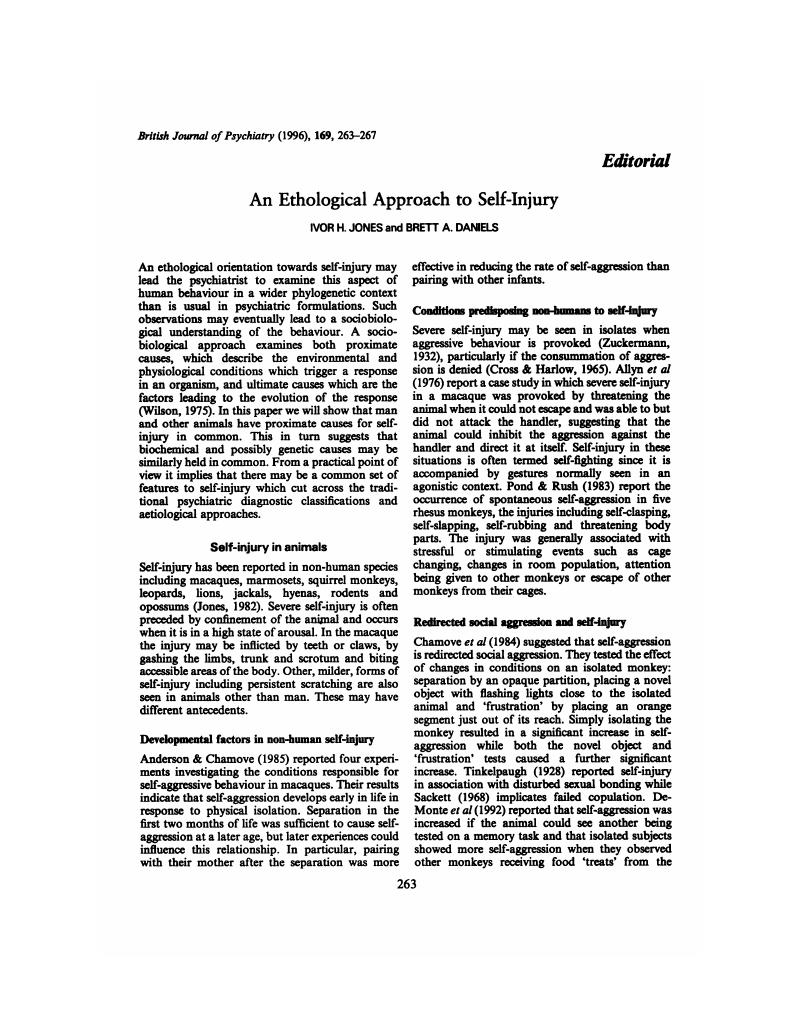Crossref Citations
This article has been cited by the following publications. This list is generated based on data provided by Crossref.
Goldney, R. D.
and
Lester, D.
1997.
Ethology and self-injury.
British Journal of Psychiatry,
Vol. 170,
Issue. 2,
p.
192.
Lester, David
and
Goldney, Robert D.
1997.
An ethological perspective on suicidal behavior.
New Ideas in Psychology,
Vol. 15,
Issue. 1,
p.
97.
TAIMINEN, TERO J.
KALLIO-SOUKAINEN, KRISTIINA
NOKSO-KOIVISTO, HANNELE
KALJONEN, ANNE
and
HELENIUS, HANS
1998.
Contagion of Deliberate Self-Harm Among Adolescent Inpatients.
Journal of the American Academy of Child & Adolescent Psychiatry,
Vol. 37,
Issue. 2,
p.
211.
Warnock, Julia K.
Burke, William J.
and
Huerter, Christopher
1999.
Self-Injurious Behavior in Elderly Patients With Dementia: Four Case Reports.
The American Journal of Geriatric Psychiatry,
Vol. 7,
Issue. 2,
p.
166.
Nijman, H.L.I.
Dautzenberg, M.
Merckelbach, H.L.G.J.
Jung, P.
Wessel, I.
and
à Campo, J.
1999.
Self-mutilating behaviour of psychiatric inpatients.
European Psychiatry,
Vol. 14,
Issue. 1,
p.
4.
Nijman, H. L. I.
Dautzenberg, M.
Merckelbach, H. L. G. J.
Jung, P.
Wessel, I.
and
Campo, J. á
1999.
Comportamiento automutilador de pacientes psiquiátricos hospitalizados.
European psychiatry (Ed. Española),
Vol. 6,
Issue. 6,
p.
352.
Corrigan, F.M.
Davidson, A.
and
Heard, H.
2000.
The role of dysregulated amygdalic emotion in borderline personality disorder.
Medical Hypotheses,
Vol. 54,
Issue. 4,
p.
574.
D. Goldney, Robert
2000.
The International Handbook of Suicide and Attempted Suicide.
p.
95.
Nijman, Henk L.I.
and
Campo, Joost M.L.G.À
2002.
Situational Determinants of Inpatient Self‐Harm.
Suicide and Life-Threatening Behavior,
Vol. 32,
Issue. 2,
p.
167.
2004.
Coping With Trauma: Hope Through Understanding, Second Edition.
p.
301.
Low, L.-F.
Draper, B.
and
Brodaty, H.
2004.
The relationship between self-destructive behaviour and nursing home environment.
Aging & Mental Health,
Vol. 8,
Issue. 1,
p.
29.
PRETI, ANTONIO
2005.
SUICIDE AMONG ANIMALS: CLUES FROM FOLKLORE THAT MAY PREVENT SUICIDAL BEHAVIOUR IN HUMAN BEINGS.
Psychological Reports,
Vol. 97,
Issue. 6,
p.
547.
Preti, Antonio
2005.
Suicide among Animals: Clues from Folklore That May Prevent Suicidal Behaviour in Human Beings.
Psychological Reports,
Vol. 97,
Issue. 2,
p.
547.
Parker, G
Parker, G
Malhi, Gin.
Mitchell, Philip
Kotze, Beth
Wilhelm, Kay
and
Parker, Kay
2005.
Self-Harming in Depressed Patients: Pattern Analysis.
Australian & New Zealand Journal of Psychiatry,
Vol. 39,
Issue. 10,
p.
899.
Parker, G
Parker, G
Malhi, Gin.
Mitchell, Philip
Kotze, Beth
Wilhelm, Kay
and
Parker, Kay
2005.
Self-Harming in Depressed Patients: Pattern Analysis.
Australian & New Zealand Journal of Psychiatry,
Vol. 39,
Issue. 10,
p.
899.
Dellinge-Ness, Lorrie Ann
and
Handler, Leonard
2006.
Self-injurious behavior in human and non-human primates.
Clinical Psychology Review,
Vol. 26,
Issue. 5,
p.
503.
Preti, Antonio
2007.
Suicide among Animals: A Review of Evidence.
Psychological Reports,
Vol. 101,
Issue. 3,
p.
831.
PRETI, ANTONIO
2007.
SUICIDE AMONG ANIMALS: A REVIEW OF EVIDENCE.
Psychological Reports,
Vol. 101,
Issue. 7,
p.
831.
Garel, Patricia
2008.
L'automutilation superficielle à l'adolescence : le corps dans tous ses états.
Cahiers critiques de thérapie familiale et de pratiques de réseaux,
Vol. n° 40,
Issue. 1,
p.
227.
Taghaddosinejad, Fakhredin
Sheikhazadi, Ardeshir
Yaghmaei, Asadolah
Vakili, Vida
Saberi, Seyed Mehdi
and
Behnoush, Behnam
2009.
A Survey of Self-Mutilation From Forensic Medicine Viewpoint.
American Journal of Forensic Medicine & Pathology,
Vol. 30,
Issue. 4,
p.
313.




eLetters
No eLetters have been published for this article.